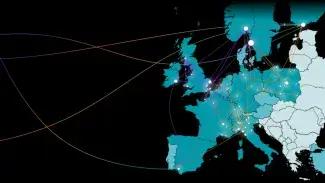In the customs brokerage industry, we deal with creating customs declarations based on documents provided by clients. These documents typically include invoices, packing lists, and CMRs. The process is complex, as declarations must be meticulously prepared and submitted to Customs Administration. Historically, this was a time-intensive task. In the past, declarations were typed on forms using typewriters. Later, computer applications and printers eased the process, but agents still spent hours grouping and calculating data with rulers and printouts. Subsequently, paper forms transitioned to electronic systems, yet inputting and processing raw data into a structured format for customs declarations remained a significant challenge.
What Sparked the Move Towards Automation in Customs?
Recognising the need for automation in customs declarations dates back many years. Observing the logistics industry, where Electronic Data Interchange (EDI) revolutionised operations, we saw potential for similar efficiencies in customs. However, the technical limitations of the time hindered progress. Poor-quality documents, particularly from goods suppliers originating in distant countries, were a key obstacle. Early advancements in OCR (Optical Character Recognition) provided limited possibilities, and we often had to rely on structured files, like XLS or CSV.
How Did Brexit Accelerate Automation Efforts?
The breakthrough came with Brexit, precisely. The sudden surge in demand for customs services, combined with a shortage of skilled personnel, necessitated alternative solutions. We began developing in-house tools to automate the creation of customs declarations. These tools monitor email inboxes, convert files such as XLS, XML, and CSV, and integrate with the WinSAD system by HUZAR to generate declarations automatically. They also handle return communication with clients and order creation in our internal workflow system. Simultaneously, we introduced RPA (Robotic Process Automation) solutions coupled with OCR for paper documents. Although effective, these were not seen as the future of automation. Thanks to these innovations, we managed the increased demand and gained valuable experience in automating customs processes.
How Has Automation Evolved Over the Years?
Our journey did not stop there. Over the years, we partnered with major clients whose needs would have been impossible to meet without automation. For instance, creating a declaration with 1,500 tariff lines based on an invoice with 14,000 rows would take an experienced agent two weeks to complete manually. With automation, we accomplish this in under two hours. Though it requires months of preparation, the investment is worthwhile.
Particularly challenging are special procedures involving not only standard declarations but also inventory management (e.g., bonded warehouses, inward processing). However, even here, our tailored solutions have proven effective. Automation allows us to take on simpler projects, offering benefits such as process standardization and reduced error rates.
What Has Changed since polish business joined Customs Support Group?
Becoming part of Customs Support Group (CSG) introduced us to cutting-edge solutions that streamlines and standardizes automation processes. It's essentially a set of multiple tools connected by one clear interface. Unlike traditional methods, Lobster includes an OCR module for paper and PDF documents, which allows us to handle projects involving unstructured data. This is what we were lacking in our solutions. This tool allows us to collaborate with clients less inclined toward automation, especially suppliers from regions like China or Bangladesh.
Our approach to automation has evolved. Previously, we prioritized projects with high returns on efficiency. Now, we also embrace simpler tasks, seeing benefits in standardization and error reduction. Automation no longer serves solely to save time but also to enhance the overall quality of our services.
Current State and Future Prospects
Today, our Polish automation team comprises three specialists. Their responsibilities include maintaining existing processes and developing new automation projects. Currently, over 40% of our customs declarations involve some degree of automation, representing more than 70% of total declaration lines. We tailor solutions to fit each project, often combining methods for optimal results.
We eagerly await the implementation of IDP (Intelligent Document Processing) solutions powered by artificial intelligence. These tools will tackle the most challenging cases, such as poor-quality documents.
What Role Do Human expertise Play in Automated Processes?
Despite fears that automation might render customs agents obsolete, the reality is different. Human oversight - "Real Intelligence" (RI) remains essential, as agents verify and sign off on declarations. Automation enables us to handle more tasks, faster, while minimizing errors, but it is human expertise that ensures the highest quality control. This balance between human oversight and technological efficiency is the direction the entire industry is heading.
We believe that human expertise is irreplaceable. While AI has its strengths, it's our 1,700 experts across Europe who truly make the difference. They are the ones guiding businesses through the complex and constantly evolving world of customs and trade regulations, offering insight and solutions that only experienced professionals can provide.
As we continue to invest in automation, we can confidently say it has been a game-changer. Automation allows us to support large-scale projects, meet increasing client expectations, and maintain our competitive edge. The journey is ongoing, but one thing is clear: automation is not replacing humans; it is empowering them to achieve more with the support of Real Intelligence.
Looking for ways to optimize your customs processes? Our experts can help you navigate automation and streamline your operations. Get in touch with us today!














